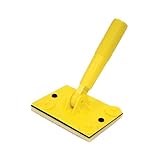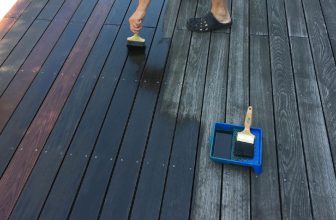Best Paint Edger in 2025: Best Models for Perfect Renovation
There are many large and small devices that can make any renovation easier on the market today. You probably know that painting walls next to skirting boards, near windows, and at the joints requires special care. That is why best paint edgers are essential. With it, your paint job will be more accurate and less messy.
However, not all devices are of high quality and perfectly flat, and you need only the best paint edging tool. Especially for you, I have picked the top 7 ideal devices that really deserve your attention. And if you can’t decide which item you need, see my detailed buyer’s guide.
Contents
- 1 Top 7 Best Paint Edger Reviews
- 1.1 1. Wagner SMART Edge Paint Roller – Top Pick
- 1.2 2. Mr. LongArm Trim Smart Paint Edger – Runner Up
- 1.3 3. Affordable Paint Trimmer: HomeRight Quick Edge Painter
- 1.4 4. Great Value: Shur-Line Paint Edger with 2 Guide Wheels
- 1.5 5. Paint Trimmer with Spare Pad: Shur-Line Trim and Touch-Up Pad
- 1.6 6. Roller Paint Edger Kit: Accubrush MX
- 1.7 7. One of the Best Paint Brushes for Edging: Wooster Brush
- 2 Edge Painters Buyer’s Guide
- 3 FAQs About the Best Tool for Edging Paint
- 4 Paint Edges with Perfect Tools
Top 7 Best Paint Edger Reviews
- Wagner SMART Edge Paint Roller – Top Pick
- Mr. LongArm Trim Smart Paint Edger – Runner Up
- Affordable Paint Trimmer
- Shur-Line 2000863 00100
- Shur-Line 1520C
- Accubrush MX
- Wooster Brush Q3211
A quality paint edger will take the hassle out of masking tape, cutting-in, paint drops, etc. Each model has its own pros and cons. Therefore, you need to take into account the specifics of the work ahead to choose the most optimal option. I’ve tried a lot of paint tools, and I can confidently recommend these seven.
1. Wagner SMART Edge Paint Roller – Top Pick
The Wagner SMART Edge Paint Roller is truly the best of its kind for its user-friendly design. There is no need to purchase an additional paint tray to use it.
Simply draw your paint using a special nozzle into a transparent tube-handle (its volume is six fluid ounces). Then press a trigger several times to wet a 3-inch roller with paint and start painting walls. The indicated amount is enough for about 96 linear feet without refilling.
In my opinion, the manufacturer should have made the roller wider so that you could cover a large area in a short amount of time. However, it can reach even hard-to-reach places. On one side, it has a special protective edging guard that allows you to draw neat and straight lines.
If you used to apply a protective tape, now you do not need it. When you’re done, simply squeeze the remaining paint into a can and rinse the tube so it can be used multiple times.
- Ergonomic design;
- One fill lasts for a long time;
- Reusable tube.
- Needs to be cleaned thoroughly;
- Its roller could be wider.
2. Mr. LongArm Trim Smart Paint Edger – Runner Up
The name of this tool speaks for itself. Its long handle allows you to reach even the farthest corners. And if necessary, you can screw this perfect paint edger to any telescopic pole. It can be used for both vertical and horizontal painting thanks to the swivel handle.
At its corners, Mr. LongArm Trim Smart Paint Edger has special wheels that let you maintain a safe distance when painting walls near skirting boards or windows so as not to get them dirty. The dimensions of the pad are 4.75×3.375 inches. When it becomes unusable, you can easily replace it.
Simply detach two plastic screws near a handle, remove the used pad, install a new one, and tighten the screws. If they have dried paint on them, don’t be afraid to pry them off with a screwdriver. I don’t think you will have to change the sponge often; it is of really remarkable quality and will serve you for a very long time.
- Has a replaceable pad;
- Durable;
- Affordable price.
- A pole not supplied;
- Pad corners fold.
3. Affordable Paint Trimmer: HomeRight Quick Edge Painter
HomeRight Quick Edge Painter’s design is very similar to the first product on my list. However, it has a smaller tube (4.5 fluid ounces) and, therefore, a lower cost. This amount of paint should be enough for about 50 linear feet, depending on the application density.
You will need to practice a little to adjust the paint flow and not squeeze out too much. Unlike the first model, it does not use a roller, but a flat 3-inch pad made of neoprene.
The head of the product turns in different directions. You can set it to one of four positions, depending on your particular job. On the head sides, two protrusions will not allow the product to go beyond the zone that does not need to be painted.
When you’re done, just pour the remaining paint into a can, and don’t forget to wash the tube. If you wish, you can additionally purchase an angle attachment and spare pads from the same manufacturer.
- Comfortable design;
- Reusable;
- Affordable price.
- Small pad size;
- The paint supply mechanism takes some practice.
4. Great Value: Shur-Line Paint Edger with 2 Guide Wheels
Shur-Line Paint Edger with 2 Guide Wheels is a versatile tool for both manual wall painting and using extension poles. It is inexpensive and easy to use.
The product has a removable 5×3 inches pad that can be washed and replaced if needed (spare pads are not included). It does an excellent job of painting even textured surfaces. Unfortunately, an extension pole is not included; however, you can screw this paint edger to any pole you have.
While there are guidewheels around the edges that move and protect things from paint drops, you need some care when painting. If you immerse the product too deep in paint, it will get caught on the edges and stain other surfaces. A painting hack to make sure this doesn’t happen: apply the paint with a brush, for example, 2 inches wide.
- Has a removable, washable mat;
- Easy-to-use;
- Inexpensive.
- Wheels get clogged with paint and stop moving;
- Require some practice.
5. Paint Trimmer with Spare Pad: Shur-Line Trim and Touch-Up Pad
A hand-held Shur-Line Trim and Touch-Up Pad is designed for painting small areas. Its head measures 1.38×3 inches, and a handle length is 9.38 inches. The kit includes a spare pad in case the first one becomes unusable.
Unfortunately, the design of this product does not allow it to be attached to a long pole. But it is not very bulky and can paint even hard-to-reach corners.
I recommend doing a little practice using this paint edger first. It is important not to immerse it too deeply into the paint and not draw too much of it; otherwise, the product will start dripping.
The manufacturer also recommends that you vacuum or wash the pad before the first use. It will get rid of the fluff that has fallen out and get the best result. Also, wash it after each use with special products depending on the paint.
- Easy to clean;
- Ideal for painting small areas;
- There is a spare pad.
- Its handle is not adjustable;
- The head does not rotate.
6. Roller Paint Edger Kit: Accubrush MX
Unlike the previous models, the Accubrush MX Paint Edger is not one piece, but a complete set with a basic tool, interchangeable rollers, and nylon brushes. The roller width is 4 inches, and the diameter is 2 inches.
On average, you can paint up to 5-8 feet per load. The item paints flat surfaces well, but may not cope with the textured ones. The rollers are reusable, but remember to wash them every time after use.

For a cleaner and smoother line, there is a small brush attached to the tool. It is meant to pick up any paint excess. In practice, it turned out that it rather smears it, leaving a thin trail. My recommendation is: just don’t put too much paint on the roller. This tool is for manual use only.
Unfortunately, there is no place here to screw it to a telescopic pole. The body is designed in such a way as to avoid getting paint on it. So you don’t have to think about dried paint.
- A lot of replaceable items;
- You can use several colors at once;
- Paint does not get on the body.
- Nylon brush does not clean paint very well;
- A bit pricey.
7. One of the Best Paint Brushes for Edging: Wooster Brush
For edging, it is not necessary to use special devices or rollers with a shield. You can do this with a specially designed brush. I recommend buying the Wooster Brush Shortcut Angle Sash Paintbrush. Its working surface is 3 inches wide, and the length of the product with a handle is 8 inches.
It is versatile and suitable for applying any base paints. The brush has a characteristic oblique cut, allowing for sharp lines and corners. A flexible plastic handle provides comfort during extended use.
The set contains 12 brushes of the same size. Such a purchase is very beneficial if you have large volumes of work ahead. The brushes are inexpensive, so you shouldn’t mind throwing them away if one of the brushes becomes unusable.
But remember to take proper care of your tool and wash it every time after use, then brushes will last even longer. They are very high quality, do not lose bristles during use, and absorb a lot of paint.
- Do not lose bristles;
- There are 12 items in a set;
- Economical option.
- May leave characteristic stripes;
- May not be suitable for those with large hands.
Edge Painters Buyer’s Guide
While compiling this list, I have taken into account all the technical characteristics and capabilities of tools that are now on the market. When choosing the paint edger that’s right for you, I recommend that you first evaluate the amount of work ahead.
Based on this, you can pick the most suitable option looking for the parameters described below.

Type of edge painting tool
There are a lot of various types of paint edgers in stores to save you the time of fiddling with masking tape. Which one to choose depends on specifics of the work ahead and your budget.
- Roll-on edgers. In such a device, the main working element is a roller, to which a special shield is attached to protect other surfaces from paint drops. The principle of working with such a tool is, in many ways, similar to using a conventional painting roller unless roll-on edgers are slightly smaller in width and diameter.
- Pad-style edgers. They use pads to apply paint. They are often small in size and absorb a little liquid, which means that you have to immerse them in the paint regularly.
- Brushes for edging. These brushes do not have a straight cut, but an angled one. It allows you to draw sharper and cleaner lines. However, precision and care are still required of you. If you press too hard on a brush, the bristles may go beyond the desired border.
Both roll-on and pad-style edgers can have improved designs with tubes instead of regular handles.
Such options are usually more expensive, but at the same time more convenient. The volume of a tube is enough for a fairly large area, so you do not have to often bend over to a paint tray.
By the way, the most budgetary option is to use a trim guard. For some reason, many people forget about such an easy way to draw straight lines.
With this tool, you can use any brush safely, just place it on the edge of the painted area and hold it while you paint.
Related Post: Best Roof Coatings & Sealers Reviewed

Size
This parameter directly depends on the work that you have to perform. The purpose of any paint edger is to paint the edge, not the entire wall.
But even in this case, you should not choose too small and narrow tools so as not to waste too much time. The devices that are too large can also be a bad option, as they are more challenging to handle.
If you need to paint an edging on a wall or ceiling (which is quite a lot of work), choose a larger paint edger. If you plan to paint furniture, skirting boards, or a door frame, then narrow models are more suitable for you.
Material
Brushes, rollers, and pads can be made of a wide variety of materials. Most often, manufacturers indicate directly on the packaging what type of work or paint this or that tool was made for. Choose the material that is perfect for your surface.
To make smooth and even walls, use rollers or pads with short fibers or foam. When painting textured surfaces with chips, scratches, or paint over the previous painting, use long-fibers rollers.
You also need to remember that a roller or pad creates a coating pattern similar to its own texture when painting.
Ease of use
Perhaps the easiest models to use are regular rollers and pads. Just pour paint into a tray, dip your tool into it, and start painting. Most of the devices are reusable and can be washed and dried. Their only downside is that you have to go back to the paint tray. If you have a lot of work ahead of you, it can be exhausting.
In this case, pay attention to tools with built-in paint containers. They are usually more expensive and require careful maintenance after each use, but they will make it easier for you to paint large areas. Remember, the more complex the design, the more difficult it is to wash the item. And it is an important point because poorly cleaned paint can dry out and ruin your tool.
Related Post: Best Fence Sealers and Stains Reviewed

Extender
An extender is essential if you plan to work with a large wall or a ceiling. It allows you to cover a large area while staying in one place. The need to climb a ladder slows down the work process significantly.
There are many models for manual use on the market; however, not all of them involve the use with an extender. Look for a tool that you can attach to a telescopic pole. Sometimes it comes in a set, while some models are universal and can be attached to any of your poles.
Related Post: Best Asphalt Crack Fillers Reviewed
FAQs About the Best Tool for Edging Paint
Here you will find answers to some popular questions about paint edgers.
How to cut in with paint?
Pour the paint into a tray, or draw it with a tube nozzle if you use a tool with a built-in container. Dip the device into the paint (not very deep) and then peel off the excess on the can edge.
Place the tool to the unpainted surface with the side on which the protective shield is attached (depending on a picked product). Take your time; the paint should be applied in smooth strokes along the baseboard or window line. If necessary, you can apply a second layer.
Do paint edgers really work?
Sure. The accuracy of a finished work depends directly on the quality of a tool. You can be sure that all of the products on my list are doing their job perfectly. But even with an excellent edger, mistakes are possible.
That is why you should not rush, and perhaps it is even better to have a little practice to cut-in when painting somewhere else. In any case, the paint can be easily removed from unwanted areas if not dried yet.
What is better for painting: edges brush or paint edger tool?
A good paint brush with edger can be a great option too, especially for those on a tight budget. However, a paint edger tool will save you the hassle of gluing masking tape, and some models — even using a paint tray. It lets you do paintwork more accurately, without the need to clean other surfaces or, worse, repaint walls.
Paint Edges with Perfect Tools
A good renovation always depends on the right paint and quality tools. Some techniques (like “cut-in”) require painstaking work and can be time-consuming. If you were wondering how to paint wall edges earlier, I hope my article has made it clearer. Choosing the right tools for painting edges will make your job much easier, including eliminating the need for repainting.
Share your tips for painting wall edges.
Do you use a paint edger? What do you prefer: a roller or pad? Or do you do a great job with a brush? Feel free to ask your question in the comments section below.
“A good tool stays with you for many years and choosing carefully ensures the job is done right, your work is neat, and the tool is always a pleasure to use”












